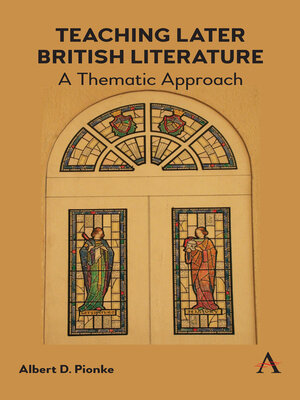
Sign up to save your library
With an OverDrive account, you can save your favorite libraries for at-a-glance information about availability. Find out more about OverDrive accounts.
Find this title in Libby, the library reading app by OverDrive.



Search for a digital library with this title
Title found at these libraries:
| Library Name | Distance |
|---|---|
| Loading... |
Designed for both first-time teachers of survey courses in later British literature and more experienced instructors seeking a new way to approach familiar material, ''Teaching Later British Literature' seeks to recapture the interconnectedness within and among Romantic, Victorian and Modern literature. Focusing on some of the defining historical, intellectual and artistic preoccupations that individual works explore in common with their literary peers, the book also invites teachers to help their students to rethink the criteria by which periods are defined and to reconceive the relationship between texts written within these periods. 'Teaching Later British Literature' is suitable for reading alongside any of the anthologies used in courses that survey the second half of British literature—from the advanced high school classroom to the lower-division university lecture hall—and seeks to complement their already robust content by offering teachers a synthetic and highly adaptable framework for guiding students through British literary history from the 1780s through the 1940s.
|There are few more intimidating moments in an English teacher's career than those in which they learn that they have been assigned 'the survey' for the first time. Distilling scores of years of literary history and thousands of pages of literary texts into a coherent semester can seem impossible at first. Add to this the fact that few teachers at the high school level receive in-depth instruction in literary history, whereas their counterparts at the college and university levels receive little preparation in syllabus construction, and the overdetermining force of available textbooks and antecedent examples tends to assert itself.
All anthologies worth their salt provide expansive biographical headnotes for individual authors and group all of the works written by those authors under their respective headnotes. Authors are typically arranged in chronological order by date of birth and their works usually appear in the order of composition and first publication. Most survey courses then faithfully reproduce this format by leading students through a series of classes, each devoted to the works of a single author. This approach has many advantages, not least that of ensuring that courses enjoy a degree of uniformity that allows for the transfer of credits between institutions. One conspicuous disadvantage of proceeding in this fashion, however, is that the intellectual distinctiveness of the period can be lost in the details of particular writers, who tend to seem rather disconnected from one another and from the historical moment of which they are a part. Put another way, and allowing for the dynamism of individual instructors and the devotion of individual readers, the knowledge gained is often enumerative rather than synthetic.
Written in response to this state of affairs, 'A Handbook to Teaching Later British Literature' ultimately advances a number of proximate, intermediate and more distant goals. Most immediately, it seeks to make individual texts of later British literature easier to understand by placing them in conversation and in context. In so doing, the book models repeatedly for new and experienced teachers the process of constructing a comparative, topic-based argument about multiple texts, something that many of them will then require their students to demonstrate in their formal papers for such courses. Through its use of culturally resonant themes grounded in specific historical events and intellectual trends, the book also seeks to make the literary periods of British Romanticism, Victorianism and Modernism more recognizable and distinct from one another,...







